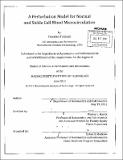A perturbation model for normal and sickle cell blood microcirculation
Author(s)
Tekleab, Yonatan
DownloadFull printable version (20.25Mb)
Other Contributors
Massachusetts Institute of Technology. Dept. of Aeronautics and Astronautics.
Advisor
Wesley L. Harris.
Terms of use
Metadata
Show full item recordAbstract
Sickle cell disease is a genetic disorder that alters red blood cells such that their hemoglobin cannot effectively bind and release oxygen. This causes issues that affect how the cell operates in the smallest vessels of the body. In the past, computational models have been used to study the microcirculation to gain a better understanding of blood disorders such as sickle cell disease. A fast, time efficient computational model has been developed to analyze perturbations in the microcirculation caused by sickle cell disease. The model uses a finite difference, Crank-Nicholson scheme for the flow and oxygen computation, while using the level set computational method to advect the red blood cell membrane on a staggered grid. A number of initial and boundary conditions were tested in the model. The simulation data shows several important parameters to be significant in the perturbation of the blood flow and oxygen concentration profiles. Specifically, the Hill coefficient, arterial oxygen partial pressure, oxygen partial pressure at 50% hemoglobin saturation, and cell membrane stiffness are significant factors.
Description
Thesis (S.M.)--Massachusetts Institute of Technology, Dept. of Aeronautics and Astronautics, 2011. Cataloged from PDF version of thesis. Includes bibliographical references (p. 143-144).
Date issued
2011Department
Massachusetts Institute of Technology. Department of Aeronautics and AstronauticsPublisher
Massachusetts Institute of Technology
Keywords
Aeronautics and Astronautics.